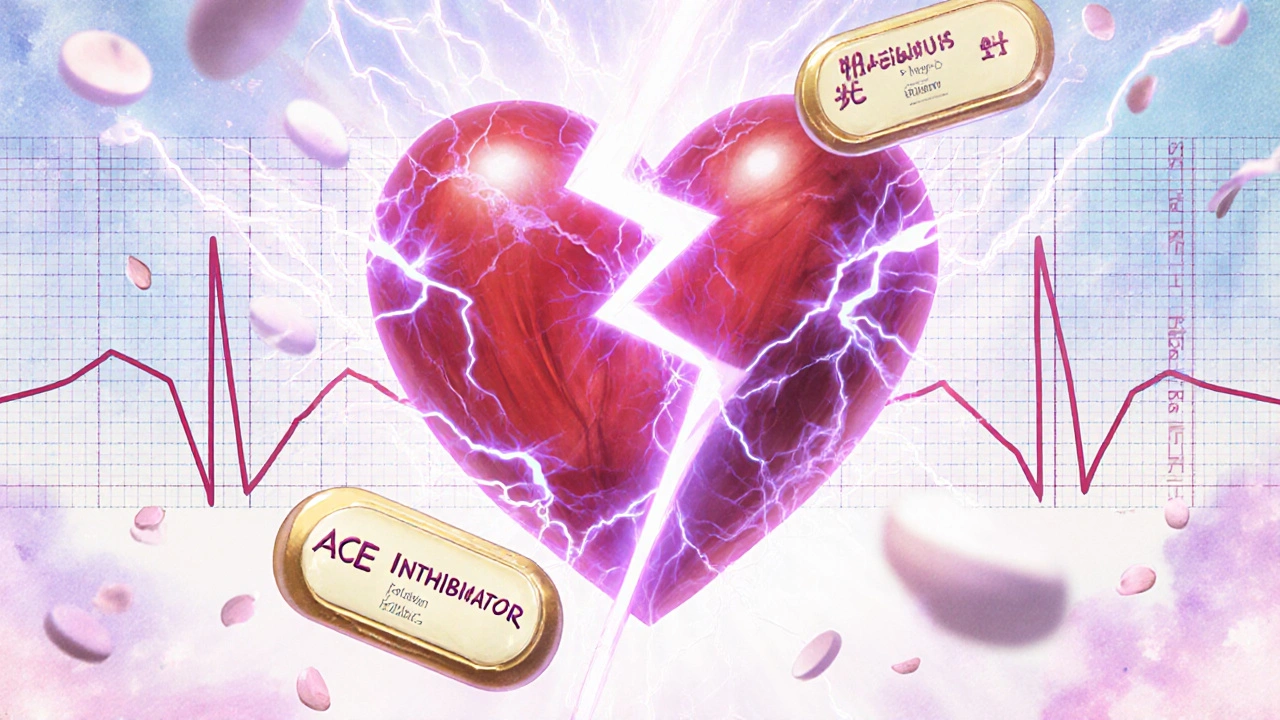Hyperkalemia Risk Calculator
Personal Risk Assessment
This calculator estimates your risk of developing hyperkalemia (high potassium levels) when taking ACE inhibitors and potassium-sparing diuretics. Based on your inputs, it will show your risk level and provide personalized recommendations.
Why Mixing ACE Inhibitors and Potassium-Sparing Diuretics Can Be Dangerous
If you’re taking an ACE inhibitor like lisinopril or enalapril for high blood pressure or heart failure, and your doctor adds a potassium-sparing diuretic like spironolactone or eplerenone, you might not realize you’re walking into a hidden risk. This combination is common-it helps control blood pressure, reduces fluid buildup, and protects the kidneys. But together, they can push your potassium levels dangerously high, leading to hyperkalemia, a condition that can trigger irregular heartbeats, cardiac arrest, or even sudden death.
Hyperkalemia means your blood potassium level is above 5.0 mmol/L. At levels over 6.0 mmol/L, it becomes life-threatening. And while many people think of potassium as just a supplement you take for muscle cramps, it’s actually a tightly controlled electrolyte that keeps your heart beating regularly. Too much, and your heart can stop.
How These Drugs Work Together-And Why That’s a Problem
ACE inhibitors block the angiotensin-converting enzyme, which lowers blood pressure by relaxing blood vessels. But they also reduce a hormone called aldosterone. Aldosterone tells your kidneys to get rid of excess potassium. When it drops, potassium stays in your blood.
Potassium-sparing diuretics like spironolactone and eplerenone do something similar: they block aldosterone receptors in the kidneys. Amiloride and triamterene work differently-they plug up the sodium channels that help flush out potassium. So both types of drugs reduce how much potassium your body can excrete.
Put them together, and you get a double hit. Your kidneys lose two major pathways to remove potassium. This isn’t just theoretical. A 1998 study in JAMA Internal Medicine found that 11% of patients on ACE inhibitors alone developed hyperkalemia. That number jumped dramatically when potassium-sparing diuretics were added.
Who’s at Highest Risk?
Not everyone on this combo will have problems-but some people are much more likely to. You’re at higher risk if you have:
- An estimated glomerular filtration rate (eGFR) below 60 mL/min/1.73 m² (signs of reduced kidney function)
- Diabetes
- Heart failure
- Baseline potassium levels already above 4.5 mmol/L
- Age over 65
One study from the Cleveland Clinic found that patients with an eGFR under 60, plus diabetes and heart failure, had a 7-point hyperkalemia risk score. Scores of 4 or higher meant they needed close monitoring-every 1 to 2 weeks after starting the combo.
And here’s something most people don’t realize: 78% of hyperkalemia cases happen within the first three months of starting these drugs. The peak? Between 4 and 6 weeks. That’s why skipping early blood tests is a big mistake.

What Happens If Potassium Gets Too High?
High potassium doesn’t always cause symptoms-until it’s too late. Some people feel fatigue, muscle weakness, or a strange tingling. But the real danger is silent: irregular heart rhythms. On an EKG, you might see tall, peaked T-waves, widened QRS complexes, or even a flat P-wave. These are warning signs your heart is struggling.
At potassium levels above 6.0 mmol/L, the risk of ventricular fibrillation or cardiac arrest spikes. Emergency treatment is needed immediately: calcium gluconate to stabilize the heart, insulin and glucose to drive potassium into cells, and sometimes dialysis.
But here’s the catch: many doctors stop the ACE inhibitor or diuretic when hyperkalemia happens. That’s understandable-but it’s often the wrong move. Studies show that stopping RAAS inhibitors (like ACE inhibitors or ARBs) increases death risk by 23% in heart failure patients and 26% after a heart attack. The goal isn’t to stop the drugs-it’s to manage the potassium safely so you can keep taking them.
How to Monitor and Prevent Hyperkalemia
Monitoring isn’t optional. It’s mandatory. Here’s what the guidelines say:
- Check potassium within 1 week of starting the combo if you have kidney disease (eGFR < 60)
- Test again at 2 and 4 weeks
- After that, check every 3 months if stable
- If your eGFR is below 30, check weekly at first
And don’t wait for symptoms. Many patients with dangerously high potassium feel fine until their heart stops.
Also, watch your diet. The FDA recommends no more than 4,700 mg of potassium per day. But many processed foods-like canned soups, meal replacements, and sports drinks-contain hidden potassium chloride as a salt substitute. One serving can add 500-1,000 mg. Avoid bananas, oranges, potatoes, tomatoes, spinach, and dried fruits if you’re at risk.
Research shows cutting dietary potassium to 50-75 mmol/day (about 2,000-3,000 mg) can lower serum levels by 0.3-0.6 mmol/L. Yet only 32% of patients get dietary counseling.
What to Do If Potassium Rises
If your potassium is between 5.0 and 5.5 mmol/L:
- Review your diet and stop potassium supplements
- Reduce the ACE inhibitor dose by 50% and retest in 1-2 weeks
- Add a thiazide diuretic like hydrochlorothiazide (12.5-25 mg daily)-this can drop potassium by 0.5-1.0 mmol/L in two weeks
If it’s above 5.5 mmol/L:
- Consider switching from spironolactone to triamterene (lower potency)
- Try switching from an ACE inhibitor to an ARB-studies show ARBs cause about 18% less hyperkalemia
- For persistent cases, potassium binders like patiromer (Veltassa) or sodium zirconium cyclosilicate (Lokelma) can safely lower potassium without stopping your heart meds
These binders work by trapping potassium in your gut so it’s excreted in stool. In trials, 89% of patients who couldn’t tolerate RAAS inhibitors due to hyperkalemia were able to restart them after using these drugs.

New Options Are Changing the Game
In 2023, the DAPA-CKD trial showed that SGLT2 inhibitors like dapagliflozin (Farxiga) not only help kidney and heart health-they also reduce hyperkalemia risk by 32% in patients on ACE inhibitors. That means a new triple therapy is emerging: ACE inhibitor + SGLT2 inhibitor + low-dose potassium-sparing diuretic. It’s safer, more effective, and keeps potassium in check.
And there’s more on the horizon. Point-of-care potassium testing devices are in late-stage trials. Imagine getting your potassium checked during a routine visit-no lab wait, no delay. By 2026, genetic testing for WNK1 gene variants may help predict who’s at highest risk before they even start these drugs.
Why So Many Doctors Miss This Risk
A 2023 AHA statement found that 41% of primary care doctors lack confidence in managing hyperkalemia. Only 28% follow recommended monitoring schedules. And shockingly, 33% of patients with potassium above 6.0 mmol/L had no follow-up test within 7 days.
This isn’t just about knowledge-it’s about systems. Many clinics don’t have alerts in their electronic records when a patient is on this combo. No one reminds the nurse to order the test. No one calls the patient back.
If you’re on this combination, don’t wait for your doctor to catch it. Ask for your potassium level after 2 weeks. Know your eGFR. Ask if you need a thiazide diuretic to balance it out. Bring a list of everything you eat. Be your own advocate.
Bottom Line: You Can Stay Safe
ACE inhibitors and potassium-sparing diuretics save lives. But they’re not harmless. The risk of hyperkalemia is real, predictable, and preventable. The key is awareness, monitoring, and smart adjustments-not stopping the drugs.
If you’re on this combo:
- Get your potassium tested within 1-2 weeks of starting
- Ask if you need a low-dose thiazide diuretic
- Limit high-potassium foods
- Don’t take over-the-counter potassium supplements
- Ask about potassium binders if levels stay high
- Keep your eGFR and blood pressure numbers handy
This isn’t about fear. It’s about control. With the right steps, you can keep your heart healthy without risking your life.
Can I take potassium supplements while on ACE inhibitors and spironolactone?
No. Taking potassium supplements while on ACE inhibitors and potassium-sparing diuretics is dangerous and can rapidly push your potassium into the life-threatening range. Even over-the-counter salt substitutes like NoSalt or Lite Salt contain potassium chloride and should be avoided. Always check labels and talk to your doctor before taking any supplement.
Is it safer to use ARBs instead of ACE inhibitors with potassium-sparing diuretics?
ARBs like losartan or valsartan carry a slightly lower risk of hyperkalemia-about 18% less than ACE inhibitors-according to multiple studies. However, the risk still exists, especially with potassium-sparing diuretics. Switching isn’t a guarantee of safety, but it can be a useful strategy if your potassium levels rise on an ACE inhibitor. Your doctor will consider your kidney function and heart condition before making the switch.
How often should I get my potassium checked?
If you have reduced kidney function (eGFR < 60), diabetes, or heart failure, get tested within 1 week of starting the combo, then again at 2 and 4 weeks. After that, every 3 months if stable. If your eGFR is below 30, check weekly at first. Even if you feel fine, don’t skip these tests-high potassium often has no symptoms until it’s too late.
Can I still eat bananas and potatoes if I’m on these drugs?
It depends on your risk level. If your kidney function is normal and your potassium is stable, occasional small portions are usually fine. But if you have kidney disease, diabetes, or heart failure, it’s best to limit or avoid high-potassium foods like bananas, potatoes, tomatoes, oranges, spinach, and dried fruit. A dietitian can help you find lower-potassium alternatives that still taste good.
What if my potassium is high but I can’t stop my heart medication?
You don’t have to choose between your heart health and your potassium levels. New medications called potassium binders-like patiromer (Veltassa) and sodium zirconium cyclosilicate (Lokelma)-can lower potassium safely without stopping your ACE inhibitor or diuretic. In clinical trials, 89% of patients who previously had to stop their heart meds were able to restart them after using these binders. Talk to your doctor if you’ve been told to stop your medication due to high potassium.








Daisy L November 21, 2025
Okay, but let’s be real-this isn’t just a medical issue, it’s a systemic failure. Doctors are overworked, EHRs are garbage, and patients are left to Google their own death sentence. I had a cousin die from this. No one checked his K+ for 3 months. He was on lisinopril + spironolactone. His last text was: ‘I feel weirdly tired.’ That’s it. No warning. No alarm. Just… gone. #WakeUpHealthcare
Anne Nylander November 22, 2025
you are SO right!! i just started this combo last month and i was scared to death until i read this. now i’m checking my potassium every 2 weeks like u said!! and i swapped my banana for apple slices 😊 you got this!!
Franck Emma November 24, 2025
Your cousin died. You’re lucky you’re still alive to type this.
Noah Fitzsimmons November 25, 2025
Wow. So you’re telling me that after 30 years of medicine, we’re only now realizing that two drugs that both block aldosterone… might raise potassium? Did we need a 1,200-word essay for this? Also, ‘potassium binders’? That’s not a drug, that’s a magic trick. And who’s paying for Veltassa? Your insurance? Mine says ‘nope’.
Eliza Oakes November 26, 2025
Actually, the real danger is that this whole ‘hyperkalemia panic’ is just Big Pharma’s way of selling you $1,200/month binders. Did you know potassium is NOT dangerous at 5.5? That’s a made-up number. My uncle’s been at 5.8 for 7 years. Still hiking. Still alive. Still laughing. Stop scaring people. Also, bananas are life.
Logan Romine November 27, 2025
It’s not the drugs that are the problem-it’s the Cartesian dualism of modern medicine. We treat potassium as a number, not a symphony. The heart doesn’t care about mmol/L-it cares about harmony. When we fracture the body into isolated variables, we forget that life is an emergent phenomenon. 🌊✨
Leo Tamisch November 28, 2025
While I appreciate the clinical rigor of this exposition, one cannot help but notice the conspicuous absence of any reference to the Hippocratic Oath’s original Greek text-specifically, the clause concerning the ‘proper stewardship of electrolytic equilibrium.’ One wonders whether the author has ever read Galen. Or, for that matter, the 1998 JAMA paper in its original PDF format. 🤔
Paula Jane Butterfield November 28, 2025
Hi everyone-nurse here. Just wanted to add: if you're on this combo and you're over 65 or have diabetes, PLEASE ask for a home BP cuff with K+ tracking. Some clinics are starting to give them out. Also, if you can't afford Veltassa, ask about sodium zirconium cyclosilicate samples-they have patient programs. And yes, you CAN eat potatoes… just boil 'em, don't bake, and ditch the skin. Small wins matter. 💪
Simone Wood November 29, 2025
Let’s not pretend this is new. The UK’s NICE guidelines have flagged this since 2017. But no-American clinicians still treat potassium like it’s a myth. And now we’re paying for it. Also, ‘potassium chloride salt substitute’? That’s not ‘hidden’-it’s in every damn ‘low sodium’ soup. I’ve seen patients consume 2,000mg in one bowl. And no one warned them. Because ‘it’s just a label.’